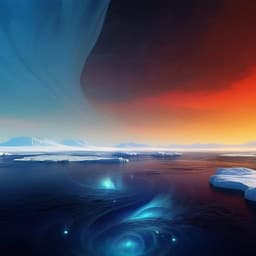
Earth Sciences
Climate change favours large seasonal loss of Arctic ozone
P. V. D. Gathen, R. Kivi, et al.
Discover how rising temperatures and human activity are impacting Arctic ozone loss in this crucial research conducted by Peter von der Gathen, Rigel Kivi, Ingo Wohltmann, Ross J. Salawitch, and Markus Rex. Their findings warn of potentially worsening conditions for ozone depletion throughout this century if greenhouse gas emissions continue to rise.
~3 min • Beginner • English
Introduction
Arctic winter and spring ozone within the polar vortex varies due to a balance of anthropogenic chemical loss and dynamical resupply, both strongly modulated by meteorology. Colder, more isolated vortices are linked to lower total column ozone, reduced resupply, and larger chemical loss because low temperatures enable PSC formation and chlorine activation. Prior studies established that the volume of air cold enough for PSCs (VPSC) relates nearly linearly to column ozone loss and suggested that the coldest Arctic winters have been getting colder, potentially due to rising greenhouse gases affecting stratospheric dynamics and temperatures. This study asks whether conditions conducive to large, seasonal Arctic ozone loss are increasing and will persist or worsen through the 21st century despite declining stratospheric halogens mandated by the Montreal Protocol. The authors examine observed and model-simulated trends in PSC Formation Potential (PFP) and combine these with halogen loading to quantify an ozone loss potential (OLP) and project future Arctic ozone loss conditions under different GHG scenarios.
Literature Review
Previous work demonstrated strong interannual variability of Arctic ozone loss driven by meteorology and established near-linear relationships between VPSC and ozone loss. Rex et al. (2004, 2006) suggested increasing maxima of VPSC tied to rising GHGs. Chemistry–climate model (CCM) studies indicated that GHG-driven changes (reduced planetary wave activity, weaker Brewer–Dobson circulation, and radiative cooling) could strengthen and cool the Arctic vortex, enhancing PSC conditions; some CCMs found modest cooling trends at 50 hPa with high variability. Studies of chlorine activation temperatures and Antarctic ozone loss rates highlighted nonlinear dependences on halogen loading. More recent analyses noted shifts in tropospheric patterns and sea surface temperatures that may reduce planetary wave activity, further strengthening the Arctic vortex. Collectively, the literature indicates that GHG increases can cool the polar stratosphere and promote PSCs, but the magnitude, variability, and significance require systematic analysis across observations and models.
Methodology
- Definitions and metrics:
- PSC Formation Potential (PFP): For each Arctic ozone loss season (Nov 1–Apr 30), compute the time-integrated fractional exposure of the polar vortex volume (VVORTEX) to temperatures below the nitric acid trihydrate stability temperature TNAT. TNAT is calculated from H2O (assumed 4.6 ppmv unless stated otherwise) and HNO3 (profile from LIMS observations) using laboratory saturation vapor pressures. Volumes are integrated over potential temperatures 400–700 K, using native horizontal grids and 6-hourly (reanalyses) or daily/6-hourly (GCM) fields. The vortex boundary is defined by normalized potential vorticity nPV = 36 s−1.
- Local maxima (LM) and trend detection: The Iterative Selection Approach (ISA) selects the upper quartile of points relative to a moving regression line by iteratively removing the most negative residuals; a linear fit to these selected LM yields slope SPFP-LM and its uncertainty. ISA performance is evaluated via Monte Carlo simulations; comparisons are made with the Maximum in Interval Method (MIM) and a fixed threshold method (VAS), showing ISA is most accurate for detecting LM trends.
- Ozone Loss Potential (OLP): OLP(year) = [EESC(year)^η / EESC_MAX] × PFP(year), where EESC is equivalent effective stratospheric chlorine (including +5 pptv VSL bromine), EESC_MAX = 4.45 ppbv, and η = 1.2 (selected by maximizing r^2 in ATLAS model runs). Uncertainty is assessed with η ∈ [1.0, 1.4].
- Regressed seasonal column ozone loss (ΔO3REG): Linear regression of measured ΔO3 against OLP (forced through origin) is used to estimate ΔO3REG time series from model-derived OLP.
- Observational and reanalysis data:
- Reanalyses: ERA5/ERA5.1 (and back extension to 1965), JRA-55 (back to 1965), MERRA-2, CFSR/CFSv2. Radiosonde biases and satellite era transitions (SSU/TOVS to AMSU/ATOVS circa 1998–1999) are considered; trends prior and after transition are compared and found consistent within uncertainties.
- Ozonesonde-based ΔO3: End-of-winter (380–550 K) column loss estimated via Match events or passive tracer differences for cold winters since 1993; uncertainties include cooling rate and vortex edge mixing.
- Modeling and projections:
- ATLAS global Lagrangian Chemistry and Transport Model: Simulates winters 2005, 2010, 2011, 2020 with comprehensive stratospheric chemistry constrained by observed halogen loading; additional sensitivity runs for 2060 and 2100 apply scaling factors to chlorine and bromine (relative to 2020) under 2020 meteorology to isolate halogen effects.
- CMIP ensembles: 26 CMIP6 GCMs (1950–2100) and 27 CMIP5 GCMs (RCP8.5) analyzed. For CMIP6, primary scenario SSP5-8.5; subset of 20 models also analyzed for SSP3-7.0, SSP2-4.5, SSP1-2.6. Recognizing model temperature and H2O biases (often warm and dry), a constant model-specific TNAT threshold offset (−9 to +9 K, integer K) is applied to align model PFPLM magnitude with ERA5-based PFPLM around year 2000 using ISA-based LM fits.
- Stratospheric H2O projections: Three cases for polar stratospheric H2O time series—(i) changes due to CH4 oxidation using a simple conversion (70% of CH4 oxidized after 6-year lag; two H2O per CH4) and SSP CH4 trajectories; (ii) thermodynamic control via tropical tropopause warming from CMIP6 multi-model means; (iii) combined effects. Time series are offset to match 4.6 ppmv in 1990. These H2O scenarios are used to recompute TNAT, PFP, OLP, and ΔO3REG.
- Statistical significance:
- For each reanalysis/GCM time series, 10 million random permutations of the PFP series are subjected to the ISA selection to derive distributions of SPFP-LM and SPFP-LM/ΔSPFP-LM; p-values quantify the likelihood of obtaining slopes/ratios exceeding observed values, accounting for the selection process.
- Sensitivity and alternate diagnostics:
- Alternate vortex boundary definitions tested; trends remain positive and significant.
- An alternative aerosol reactivity potential (ARP) using TACL (temperature for chlorine activation) yields slopes similar to PFP-based results, supporting robustness.
- QBO representation across GCMs is assessed; projections segregated by QBO realism show similar ΔO3REG/OLP behavior.
Key Findings
- Observed ozone loss vs PSC exposure:
- Measured and modeled end-of-winter Arctic column ozone loss (ΔO3, 380–550 K) relates nearly linearly to PFP for contemporary conditions (1993–2020 for data; 2005–2020 for ATLAS). When including future halogen-scaling ATLAS runs (2060, 2100) under 2020 meteorology, ΔO3 falls below the contemporary ΔO3–PFP relation due to declining EESC.
- Combining PFP with EESC via OLP greatly improves explanatory power: r^2 ≈ 0.89 (observations) and 0.96 (ATLAS) for ΔO3 vs OLP, using exponent η = 1.2.
- Trends in cold-winter PSC conditions (PFPLM):
- Reanalyses (ISA-selected LM, SPFP-LM; d/decade):
- 1980–2020: ERA5/ERA5.1 = 4.50 ± 0.19; JRA-55 = 3.91 ± 0.35; MERRA-2 = 3.85 ± 0.40; CFSR/CFSv2 = 4.77 ± 0.48. Mean ±1σ = 4.26 ± 0.45 d/decade. p-values for SPFP-LM/ΔSPFP-LM < 0.01 (most < 0.001), indicating >2σ significance.
- 1965–2020: ERA5 (with back extension) = 3.84 ± 0.34; JRA-55 = 3.50 ± 0.29 d/decade; both highly significant.
- Interpretation: During particularly cold winters, Arctic exposure to PSC conditions increased by ~3.5–4.8 days per decade (~40% increase over ~50 years).
- CMIP6 (SSP5-8.5, 26 models, 1951–2100; with model-specific TNAT offsets): All models show positive SPFP-LM, range 0.62 ± 0.09 to 3.66 ± 0.16 d/decade. SPFP-LM significant at >2σ for 16/26 (slope) and 24/26 (slope/uncertainty). Most models peak PFP toward end-century. CMIP5 (RCP8.5) shows similar behavior. Mean SPFP-LM (1950–2100): CMIP6 = 1.71 ± 0.7 d/decade; CMIP5 = 1.48 ± 1.0 d/decade. 52/53 CMIP5/6 8.5-W m−2 runs have positive SPFP-LM.
- Across SSPs (20 CMIP6 models): SPFP-LM largest for SSP5-8.5 and smallest (near zero in many cases) for SSP1-2.6, linking increased PFP to higher radiative forcing.
- Influence of rising stratospheric H2O:
- Allowing H2O to rise via CH4 oxidation and tropical tropopause warming substantially increases PFP trends under high-forcing scenarios. Example (EC-Earth3, SSP5-8.5): SPFP-LM increases from 2.27 ± 0.13 d/decade (time-invariant H2O) to 3.93 ± 0.13 d/decade (full H2O). Effects are smaller for SSP2-4.5 and SSP1-2.6.
- Projections of ozone loss potential and regressed column loss (ensemble means, 20 CMIP6 models):
- With constant H2O, OLP remains above 1980 levels to 2100 for SSP5-8.5 and SSP3-7.0; ΔO3REG of ~70–100 DU persists to 2100, comparable to contemporary values. For SSP2-4.5, OLP approaches 1980 levels; for SSP1-2.6, OLP and ΔO3REG reach 1980 levels by century end.
- With variable (rising) H2O, end-century OLP and ΔO3REG exceed contemporary values for SSP5-8.5 and SSP3-7.0; for SSP2-4.5 they lie above 1980; for SSP1-2.6 both drop below 1980 due to suppressed CH4 and reduced H2O.
- Model process representation:
- CMIP6 models show improved QBO representation relative to CMIP5, but grouping models by QBO realism yields similar OLP/ΔO3REG projections. GCMs with interactive chemistry (4/20) project OLP evolution ~20–25% lower by end-century than models with prescribed ozone, yet ΔO3REG remains near contemporary values to 2100 under SSP3-7.0 and SSP5-8.5.
- Overall conclusion from findings: Rising GHGs cool the Arctic lower stratosphere and, together with increasing H2O, increase the frequency and intensity of conditions conducive to large seasonal ozone loss, potentially persisting or worsening through 2100 under high-emission pathways despite declining halogens.
Discussion
The analysis shows that the cold extremes of Arctic stratospheric temperatures—captured by the local maxima of PSC Formation Potential—have increased over recent decades and are projected to continue increasing with higher greenhouse gas forcing. This links climate change directly to enhanced conditions for chlorine activation and ozone-destroying chemistry. By combining PFP with halogen loading into OLP, the study explains most of the variance in observed and modeled seasonal ozone losses, demonstrating that both available halogens and cold exposure control Arctic ozone depletion.
Despite expected declines in anthropogenic halogens due to the Montreal Protocol, projections indicate that under high-forcing scenarios (SSP5-8.5, SSP3-7.0), stratospheric cooling plus rising stratospheric humidity (from CH4 increases and a warmer tropical tropopause) can sustain or even intensify the potential for large seasonal ozone losses through the end of the 21st century. Ensemble means mask substantial year-to-year variability but indicate persistent high OLP and ΔO3REG under strong forcing. Under moderate to low forcing (SSP2-4.5 and especially SSP1-2.6), OLP and ΔO3REG decline toward or below 1980 levels by century end, highlighting mitigation benefits.
The observationally inferred SPFP-LM over 1980–2020 lies near the upper range of GCM projections, potentially influenced by internal variability (e.g., reduced planetary wave activity since the early 2000s) and tropospheric SST patterns that strengthen the vortex. Model differences in stratospheric resolution, QBO representation, and interactive chemistry affect quantitative projections but not the qualitative conclusion that higher GHG forcing increases the prevalence of cold-vortex conditions conducive to ozone loss. The findings imply that climate change can partially offset ozone recovery benefits in the Arctic, with implications for springtime UV exposure and atmospheric composition. Future Arctic total column ozone will reflect a complex balance among initial ozone, dynamical transport (e.g., intensifying BDC), and chemical loss.
Conclusion
This study introduces and applies a robust metric—PSC Formation Potential (PFP) and its local maxima—to quantify cold exposure conducive to Arctic ozone loss, and combines it with halogen loading into an Ozone Loss Potential (OLP) framework that accurately reproduces observed and modeled seasonal losses. Analyses of multiple reanalyses reveal statistically significant increases in cold-winter PFP over the past 40–55 years. Across 53 CMIP5/6 high-forcing simulations, nearly all show increasing PFP to 2100, with trends scaling with greenhouse gas radiative forcing. Accounting for projected increases in stratospheric H2O further amplifies future PFP and OLP under strong forcing.
Main contributions:
- Demonstration of significant, long-term increases in Arctic cold-winter PSC exposure (PFPLM) in observations and models.
- Development and validation of the ISA method for trend detection of local maxima and the OLP framework linking halogens and cold exposure to ozone loss.
- Multi-model, multi-scenario projections showing that high GHG pathways can maintain or worsen conditions for large seasonal Arctic ozone loss through 2100, despite declining halogens; mitigation scenarios reduce this risk.
Future research directions:
- Improve GCM stratospheric processes (vertical resolution, wave dynamics, QBO amplitude) and expand use of interactive chemistry to capture feedbacks.
- Better constrain and homogenize polar stratospheric H2O observations and projections, including CH4 oxidation efficiency and tropical tropopause controls.
- Quantify roles of internal variability (planetary wave activity, SST patterns) and sea ice changes on Arctic vortex strength and PFP.
- Integrate denitrification, sulfate aerosol variability, and N2O-driven HNO3 changes into prognostic PSC and ozone loss projections.
- Assess impacts on surface UV and biosphere under different emission pathways considering both chemical and dynamical ozone drivers.
Limitations
- Model biases: Many GCMs exhibit warm biases (up to ~5 K) and low stratospheric H2O, necessitating PSC threshold offsets; results depend on this calibration.
- Chemistry representation: Most CMIP6 models use prescribed ozone; only a subset includes interactive chemistry, which yields ~20–25% lower OLP evolution by end-century.
- Stratospheric dynamics: Limited vertical resolution and imperfect QBO amplitude (especially below 20 hPa) affect realism of polar vortex and wave–mean flow interactions.
- Observational uncertainties: Pre-1979 reliance on radiosondes with known biases; instrument transitions (SSU/TOVS to AMSU/ATOVS) may introduce inhomogeneities, though trends appear robust across eras.
- OLP formulation: Choice of EESC exponent (η = 1.2) optimized using limited ATLAS runs; uncertainty bounded using η ∈ [1.0, 1.4].
- PSC microphysics and denitrification: Simplified treatment via TNAT threshold; explicit denitrification and aerosol microphysics are not fully represented in PFP/OLP metrics.
- Stratospheric H2O projections: Simplified CH4-to-H2O conversion (fixed 70%, 6-year lag) and multi-model mean TTL warming; real-world variability and model spread introduce uncertainty.
- Internal variability: Decadal changes in planetary wave activity and SST patterns can modulate Arctic vortex conditions, complicating attribution over short periods.
Related Publications
Explore these studies to deepen your understanding of the subject.







